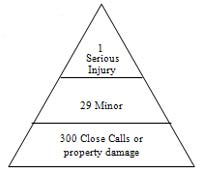
Handy Links
SLAC News Center
SLAC Today
- Subscribe
- Archives: Feb 2006-May 20, 2011
- Archives: May 23, 2011 and later
- Submit Feedback or Story Ideas
- About SLAC Today
SLAC News
Lab News
- Interactions
- Lightsources.org
- ILC NewsLine
- Int'l Science Grid This Week
- Fermilab Today
- Berkeley Lab News
- @brookhaven TODAY
- DOE Pulse
- CERN Courier
- DESY inForm
- US / LHC
SLAC Links
- Emergency
- Safety
- Policy Repository
- Site Entry Form

- Site Maps
- M & O Review
- Computing Status & Calendar
- SLAC Colloquium
- SLACspeak
- SLACspace
- SLAC Logo
- Café Menu
- Flea Market
- Web E-mail
- Marguerite Shuttle
- Discount Commuter Passes
-
Award Reporting Form
- SPIRES
- SciDoc
- Activity Groups
- Library
Stanford
Around the Bay
Why Track Close Calls?
 In 1986 the Space-Shuttle Challenger exploded soon after lift-off due to faulty
o-rings. Engineers working on the shuttle had, previous to the accident, noted that that some of the
o-rings used in other shuttle missions were degrading. Management had been informed the night before the launch of Challenger for the potential for such failure.
In 1986 the Space-Shuttle Challenger exploded soon after lift-off due to faulty
o-rings. Engineers working on the shuttle had, previous to the accident, noted that that some of the
o-rings used in other shuttle missions were degrading. Management had been informed the night before the launch of Challenger for the potential for such failure.
Was previous reporting of the o-ring degradation a Close Call?
A Close Call is defined as an unplanned sequence of events that could have caused harm if conditions were different or are allowed to progress, but did not in this instance.
In hindsight, this disaster may have been prevented.
Why track Close Calls? The behaviors and conditions that lead to actual accidents and injuries are the same as those involved in Close Calls. If we can get an idea of what almost happened, we can help prevent accidents and injuries that do happen. This is a much cheaper method of prophylaxis (both in terms of human and financial costs).
In 1931, H.W. Heinrich reported on a study of accidents that he classified according to severity. Heinrich's report showed that for each serious-injury incident, we could expect about 29 minor injuries and 300 Close Call or property-damage incidents, as represented in the above diagram.
A category that should be added to the base of this safety-pyramid is "Unsafe/Hazardous Conditions and Behaviors." This is what fuels the other events in the pyramid.
If we decide to track Close Calls, what do we do with the information?
1. Investigate the Close Call and find out what happened, what could have happened and why.
2. Distribute that information so others can learn from it.
3. Fix or mitigate the condition or event that resulted in the Close Call.
4. Continue to monitor and encourage Close Call reporting.
If we can take these steps, and encourage our employees to report Close Calls without the fear of reprisal, the work environment will improve, employees will feel empowered to participate in their safety and we will have a safer workplace.
More information about Close Calls is available at the ES&H website.
—Tom Rizzi
SLAC Today, October 24, 2006